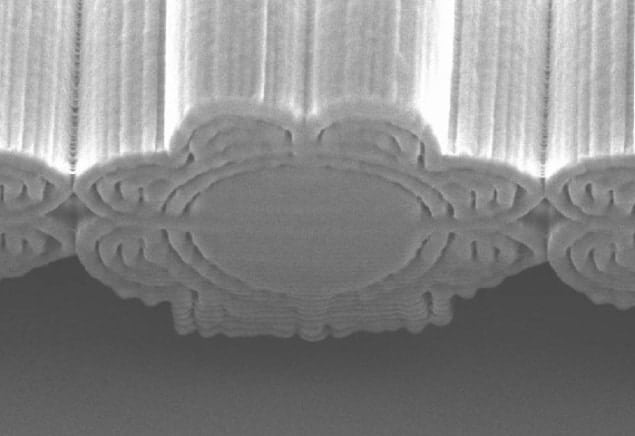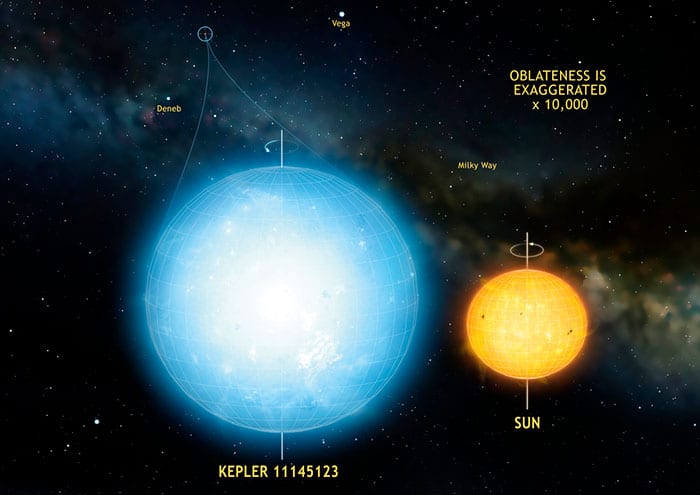Flash Physics is our daily pick of the latest need-to-know developments from the global physics community selected by Physics World‘s team of editors and reporters

Spider and flowers inspire new structural colour
A blue spider has inspired researchers to create a new material with structural colour that does not change with the viewing angle. Materials with structural colour get their hues from the interference of reflected light from tiny structures. Some structural colour – such as seen on the feathers of some birds or the reflection from a CD – is iridescent, which means that the observed colour changes with the angle of observation. Other naturally occurring structural colour remains constant irrespective of the observer, and it is this type of structural colour that researchers have struggled to recreate in the laboratory. Now, Radwanul Hasan Siddique and colleagues at the Karlsruhe Institute of Technology in Germany have teamed up with researchers in the US and Belgium to create a material that has a structural colour that is the same when viewed over 160°. Resembling an array of tiny flowers – each about 15 μm across – the material has a hierarchical structure that has translational and rotational symmetries at a number of different length scales (see image above). This geometry ensures that there are no special directions in how light is reflected. The material was inspired by the blue tarantula, which has non-iridescent structural colour. The material is described in Advanced Optical Materials and its colour can be adjusted by changing the size of the flowers. The researchers believe it could be an important step towards creating non-toxic, vibrant and durable colours for textiles and other applications.
Astronomers spot the roundest natural object in the universe

Consider a spherical star in the vacuum of outer space. Thanks to recent observations made by a team of researchers at the Max Planck Institute for Solar System Research (MPS) and the University of Göttingen, both in Germany, this may no longer be a hypothetical scenario. Most stars are not perfect spheres – their shape is determined by their rotation speeds: the faster the rotatation, the more oblate the shape. But as stars appear to us as mere points on the sky, their shapes are difficult to measure. Now, a team led by Laurent Gizon at MPS has, for the first time, measured the oblateness of a star, with unprecedented precision. Gizon and colleagues used “asteroseismology” or the study of the oscillations of stars. The applied the method on a slowly rotating star (Kepler 11145123), which is some 5000 light-years from Earth. They found that the difference between the equatorial and polar radii of the star is only 3 km – a very small amount compared to the star’s mean radius of 1.5 million km. Kepler 11145123 rotates at one third the angular velocity of the Sun, which rotates once every 27 days. The distant star also supports only sinusoidal oscillations, meaning its periodic expansions and contractions can be detected via its luminosity. NASA’s Kepler mission observed the star’s oscillations continuously for more than four years and found the virtually negligible difference in radius. “This makes Kepler 11145123 the roundest natural object ever measured, even more round than the Sun,” says Gizon. The work is described in Science Advances.
Quantum simulator is very fast
A team of physicists is claiming the record for the world’s fastest quantum simulator. The system involves cooling an ensemble of about rubidium-87 atoms to a temperature of about 70 μK. The atoms are then put into highly excited Rydberg states by firing an ultrashort 10 ps (10–11 s) laser pulse at the ensemble. Rydberg atoms have very large radii and therefore will interact very strongly with each other. This ensemble can then be used to simulate strongly correlated quantum systems such as electrons in superconductors and magnets. In the team’s experiment, a first pulse is followed by a second 10 ps pulse, which is used to measure how the atoms are interacting with each other. The time delay between the pulses can be controlled on the 10 as (10–17 s) scale and this allowed the researchers to observe a coherence oscillation in the gas with a period of 1 fs (10–15 s). The research is reported in Nature Communications and has been done by an international team that included Nobuyuki Takei and Christian Sommer of the National Institutes of Natural Sciences in Okazaki, Japan.
- You can find all our daily Flash Physics posts in the website’s news section, as well as on Twitter and Facebook using #FlashPhysics.



